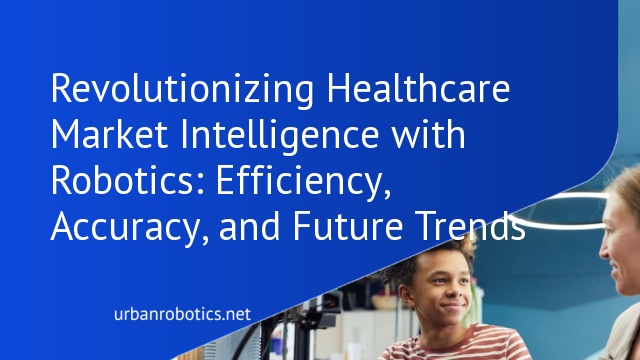Understanding Healthcare Market Intelligence
Healthcare market intelligence involves gathering, analyzing, and interpreting data to make informed business decisions. Robotics plays a significant role in streamlining these processes, offering deeper insights and operational efficiency.
Key Components of Healthcare Market Intelligence
Key components include data collection, data analysis, and actionable insights. Data collection involves gathering large datasets from various sources, such as electronic health records and market reports. Data analysis uses algorithms to identify trends and patterns. Actionable insights turn analyzed data into strategic decisions that support business objectives.
Importance for Industry Stakeholders
Healthcare market intelligence is crucial for stakeholders, including healthcare providers, payers, and pharmaceutical companies. Providers can improve patient care by understanding treatment trends. Payers can develop better pricing strategies based on cost patterns. Pharmaceutical companies can enhance R&D efforts, targeting unmet medical needs more effectively.
Role of Robotics in Healthcare
Robotics is revolutionizing healthcare, offering precise and efficient solutions to various needs. Let’s delve into how advancements in robotic technologies and their diverse applications are transforming the sector.
Advances in Robotic Technologies
Robotic technologies have progressed rapidly, enabling more sophisticated healthcare solutions. Advances include AI integration, improved sensors, and better human-robot interaction. AI integration enhances decision-making and diagnostics, while advanced sensors provide more accurate data collection. Enhanced human-robot interaction ensures safer and more effective patient care. These innovations contribute significantly to the healthcare market intelligence domain by improving data accuracy and operational efficiency.
Applications of Robotics in Healthcare
Robotics finds applications in numerous healthcare areas, improving efficiency and outcomes. Surgical robots assist in minimally invasive procedures, offering precision and reducing recovery times. Telepresence robots enable remote consultations, expanding access to healthcare. Rehabilitation robots support patient recovery by providing consistent and tailored therapy sessions. These applications optimize resource allocation and improve patient care, aligning with the goals of healthcare market intelligence.
Integration of Robotics and Market Intelligence
Combining robotics with market intelligence reshapes the healthcare landscape, bringing efficiency and precision to processes. This integration yields improved insights and decision-making capabilities.
Data Collection and Analysis
Robotics in healthcare market intelligence enhances data collection and analysis. Automated bots can efficiently gather vast amounts of data from multiple sources. This data, when processed by advanced algorithms, identifies emerging trends and patterns. For example, healthcare providers can monitor patient outcomes and treatment effectiveness by analyzing this data, enabling timely interventions and better resource management.
Enhancing Decision-Making Processes
Robotics supports refined decision-making processes in healthcare. With accurate data from various sources, robotic systems assist in creating actionable insights. For instance, automated reports generated from analyzed data help healthcare executives make evidence-based decisions quickly. This results in more efficient operational strategies, optimized resource allocation, and improved patient care quality.
Benefits of Robotics-Driven Market Intelligence
Healthcare market intelligence driven by robotics offers multiple advantages, enhancing data processes and ultimately fostering better-informed decisions.
Improved Efficiency and Accuracy
Robotics streamline data collection and analysis, leading to faster and more accurate results. Algorithms identify trends with precision, translating complex data into actionable insights quicker than manual methods. As a result, healthcare organizations can make timely decisions, improving patient outcomes and operational efficiency.
Cost Reduction and Resource Optimization
Adopting robotics in market intelligence reduces operational costs by automating routine tasks. This automation frees up human resources for higher-value activities, optimizing workforce deployment. Additionally, robotics minimize errors, leading to cost savings on rectifications and inefficiencies, thus maximizing the overall resource utility in healthcare management.
Challenges and Considerations
Our integration of robotics into healthcare market intelligence presents several challenges and considerations. Let’s explore the most prominent aspects.
Technical and Ethical Challenges
Deploying robotics in healthcare market intelligence introduces technical and ethical difficulties. Ensuring data privacy and security becomes paramount, as sensitive patient information must be safeguarded. Limitations in AI algorithms may hinder the accuracy of insights, disrupting decision-making. Ethical concerns, including biased data sets and algorithm transparency, pose significant risks. Addressing these challenges requires advanced security protocols, robust algorithm development, and ethical guidelines adherence.
Regulatory and Compliance Issues
Navigating regulatory frameworks and compliance standards is essential when implementing robotics in healthcare market intelligence. Compliance with HIPAA and GDPR is mandatory to protect patient data and maintain legal integrity. Variations in international regulations complicate global deployment. Adhering to these regulations ensures patient privacy and organizational reliability. Robust compliance strategies must be developed, considering regional and international laws to achieve successful implementation and operation.
Future Trends and Innovations
Adopting robotics in healthcare market intelligence is revolutionizing the industry. Future trends promise even more transformative changes.
Predictive Analytics with Robotics
Integrating robotics with predictive analytics enhances forecasting accuracy. Advanced robots analyze vast datasets to identify patterns and predict future trends. Implementing machine learning algorithms, these robots provide insights that support decision-making in patient care. For example, predicting patient admissions helps manage hospital resources efficiently. Additionally, predictive maintenance of medical equipment reduces downtime, ensuring continuous care.
Potential Impact on Healthcare Industry
Robotics in market intelligence is set to redefine the healthcare landscape. Automating routine data analysis tasks frees up human resources for more complex functions. This shift increases efficiency and accuracy, leading to cost savings. Enhanced data integration capabilities enable personalized care, improving patient outcomes. For instance, real-time data analysis helps in crafting tailored treatment plans. Moreover, the scalability of robotics allows for handling increasing volumes of data without compromising quality.
Conclusion
Embracing robotics in healthcare market intelligence holds transformative potential for our industry. As we navigate the complexities of technical, ethical, and regulatory challenges, it’s clear that the benefits far outweigh the hurdles. By leveraging advanced robotics, we can achieve unprecedented levels of efficiency, accuracy, and resource optimization.
Predictive analytics and data integration capabilities will revolutionize patient care, offering personalized treatment plans and enhanced forecasting. As we continue to innovate, the scalability of robotics will enable us to manage vast datasets effectively, driving cost savings and improved decision-making. The future of healthcare market intelligence with robotics looks promising, and we’re excited to be part of this groundbreaking journey.





